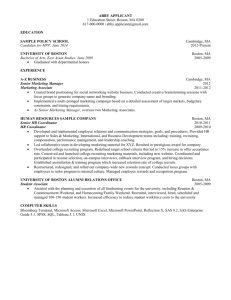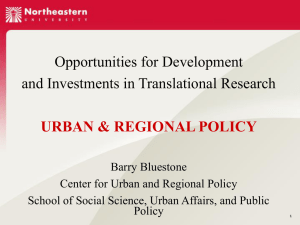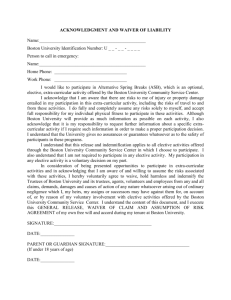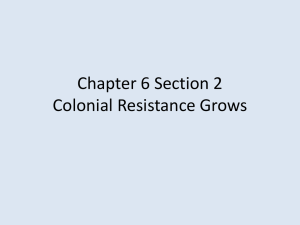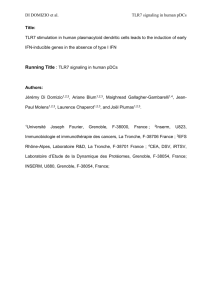Horne-Cohen-Bucay-et-al-2015-GSI-Abstract
advertisement
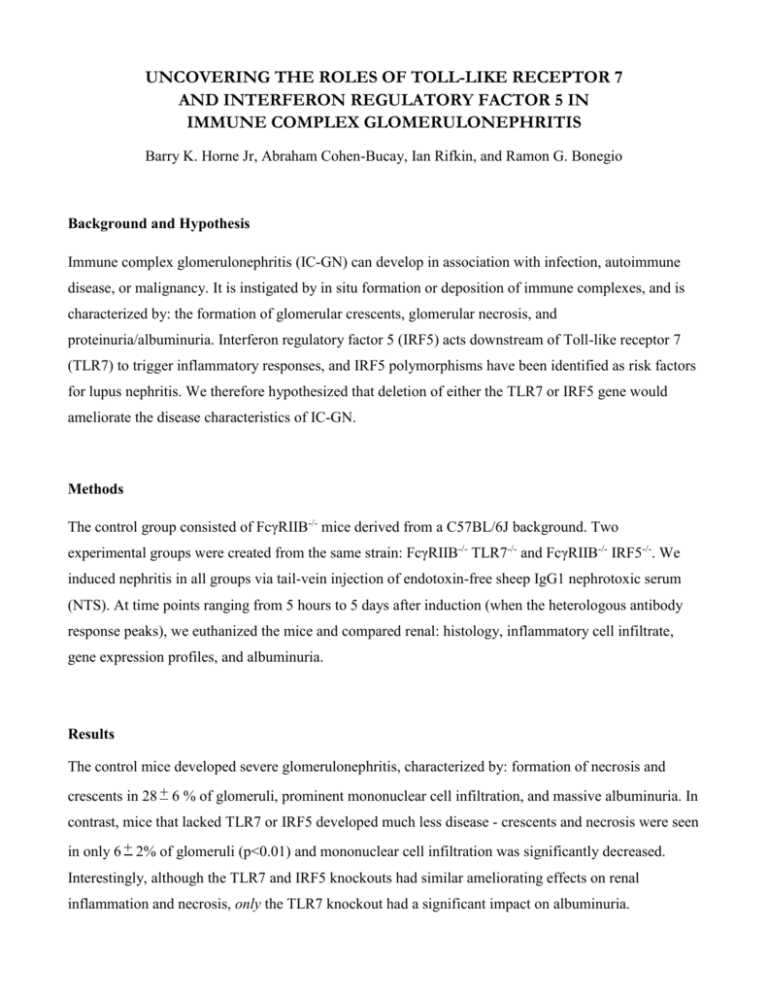
UNCOVERING THE ROLES OF TOLL-LIKE RECEPTOR 7 AND INTERFERON REGULATORY FACTOR 5 IN IMMUNE COMPLEX GLOMERULONEPHRITIS Barry K. Horne Jr, Abraham Cohen-Bucay, Ian Rifkin, and Ramon G. Bonegio Background and Hypothesis Immune complex glomerulonephritis (IC-GN) can develop in association with infection, autoimmune disease, or malignancy. It is instigated by in situ formation or deposition of immune complexes, and is characterized by: the formation of glomerular crescents, glomerular necrosis, and proteinuria/albuminuria. Interferon regulatory factor 5 (IRF5) acts downstream of Toll-like receptor 7 (TLR7) to trigger inflammatory responses, and IRF5 polymorphisms have been identified as risk factors for lupus nephritis. We therefore hypothesized that deletion of either the TLR7 or IRF5 gene would ameliorate the disease characteristics of IC-GN. Methods The control group consisted of FcγRIIB-/- mice derived from a C57BL/6J background. Two experimental groups were created from the same strain: FcγRIIB-/- TLR7-/- and FcγRIIB-/- IRF5-/-. We induced nephritis in all groups via tail-vein injection of endotoxin-free sheep IgG1 nephrotoxic serum (NTS). At time points ranging from 5 hours to 5 days after induction (when the heterologous antibody response peaks), we euthanized the mice and compared renal: histology, inflammatory cell infiltrate, gene expression profiles, and albuminuria. Results The control mice developed severe glomerulonephritis, characterized by: formation of necrosis and crescents in 28 + 6 % of glomeruli, prominent mononuclear cell infiltration, and massive albuminuria. In contrast, mice that lacked TLR7 or IRF5 developed much less disease - crescents and necrosis were seen in only 6 + 2% of glomeruli (p<0.01) and mononuclear cell infiltration was significantly decreased. Interestingly, although the TLR7 and IRF5 knockouts had similar ameliorating effects on renal inflammation and necrosis, only the TLR7 knockout had a significant impact on albuminuria. Conclusions IRF5 signaling downstream of TLR7 promotes glomerular inflammation and necrosis – but not albuminuria – during the heterologous phase of IC-GN. Since the TLR7-/- group showed decreased albuminuria however, we therefore propose a model in which TLR7 engagement triggers inflammation in an IRF5-dependent manner, while also inducing albuminuria in an IRF5-independent manner. These distinct pathways may be operating in the same cell, or they may be cell-type specific. We therefore conclude that the TLR7/IRF5 pathway is a rational target for the control of inflammation in IC-GN, and that one of TLR7’s other downstream pathways may present a novel target for alleviating the concomitant albuminuria. About the Authors / Contributors Barry K. Horne Jr PhD Student (3rd Year), Graduate Program in Genetics and Genomics Graduate Research Assistant, Bonegio Lab Graduate Medical Sciences Division, Boston University School of Medicine Abraham Cohen-Bucay MD Renal Research Fellow (3rd Year), Bonegio Lab Division of Nephrology, Department of Medicine Boston Medical Center Ian Rifkin MD, PhD Associate Professor Boston University School of Medicine Division of Nephrology, Department of Medicine Boston Medical Center Ramon G. Bonegio MD, PhD Assistant Professor Boston University School of Medicine Division of Nephrology, Department of Medicine Boston Medical Center Horne BK Jr, Cohen-Bucay A, Rifkin IR, and Bonegio RG


